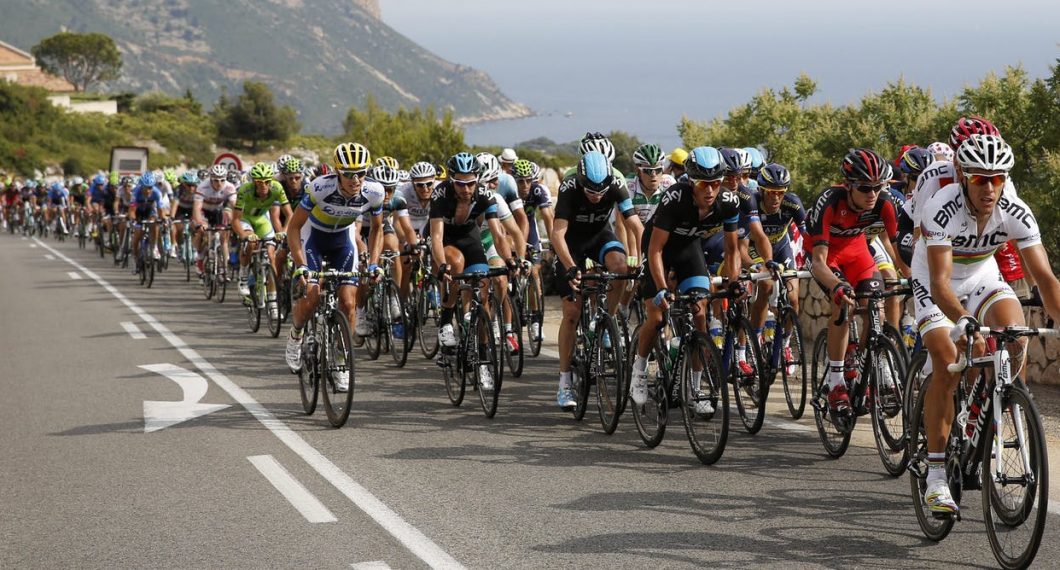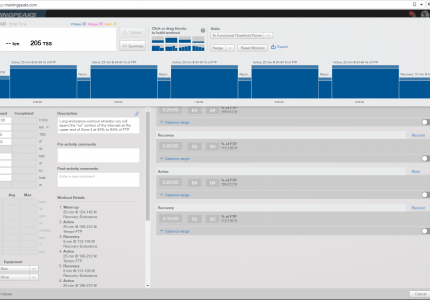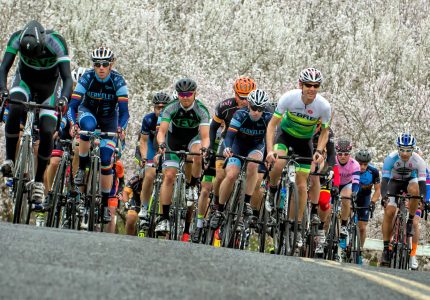This is a part 2 of a 2 part discussion and presentation of the energy systems and their place and role in cycling performance and training. Read Part 1.
The Energy Systems and Training?
Training will make demands on all of your energy systems, combining efforts from sprints (ATP-Pcr), one minute bursts (lactic acid system), 3 to 5 minute maximal aerobic efforts, and long rides over multiple hours for aerobic endurance development. Eventually as your training gets more specific, whether during a season, or through your emphasis upon certain types of cycling events, or individual training targets, you will put greater emphasis on individual energy systems and their development.
The awareness of the role and contribution of your energy systems may also come in handy when racing. Anytime you are on the bike ask yourself, “where is my energy coming from?” or, “what energy have I burnt recently?” Knowing where you are drawing energy from will help you answer many questions, such as how much you might have in reserve and how you should fuel and replenish at critical points during training and racing, and how long you should rest before you can go again at max capacity.
The training workouts you do on a daily, weekly, and monthly basis can be described in reference to your energy systems, in addition to the intensity and duration values that are typically prescribed. You or your coach, should be adding it in for context and explanation in the notes portion of your workout software, such as in Training Peaks™. This will provide understanding as to why you are working particular energy systems with different types of workouts at different times of the year.
These steps will be important for appreciating the rationale for training when you review training history. It also helps explain why a particular effort on the bike, such as a one minute hill climb at full effort, or a 30 minute flat time trial, feels and plays out like it does.
For example (Figure 6, below), a coach might offer the following workout description, designed to stress the anaerobic glycolitic system (Zone 6), stating;
“Today complete a 100 minute workout that will principally stress your anaerobic lactic acid system utilizing slow glycolysis.
Start a warm up @ 50-60% of FTP for 10 min, then complete two sets of ten 1 min 30 sec intervals at 130% to 135% of FTP (LA system stress), with 2 minute Zone 1 low aerobic recovery at 50% of FTP and 10 min @ Zone 2 aerobic effort 65% between the two sets.
Such efforts will develop an increased ability to make short hard efforts such as surging on a hill or bridging to a group in a race less costly to your overall available energy, and delay fatigue onset from performing such efforts.”
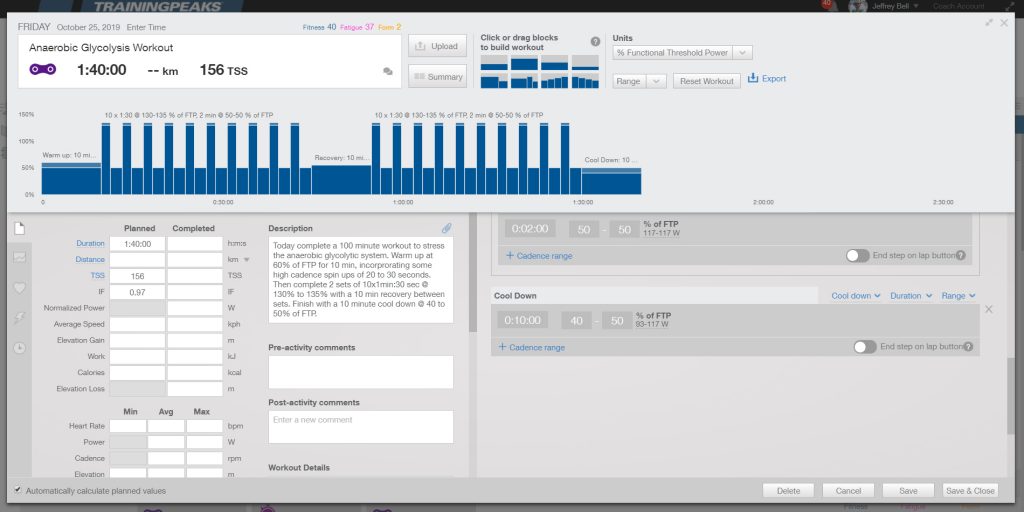
Energy System Exploitation in Phases of Training
The phases of a periodized training schedule will always be targeting energy systems either specifically or indirectly as a secondary system development. The aerobic system is the larger of the physiological systems and will dominate a great deal of the training schedule of all cycling athletes. The task for a coach or athlete is to balance the workout load based on time constraints to elicit the maximum development of the needed capacities. The simplest break down is aerobic endurance development, maximal aerobic capacity, anaerobic capacity, with neuromuscular (sprint) capability developed as needed.
Aerobic development
In the early part of a training program, or the base phase of a seasonal/annual training plan, the training emphasis will typically be centered on aerobic endurance development. The goal, being to increase the body’s ability to utilize fat and long term carbohydrate stores. This endurance aspect of aerobic development is critical for the later development of higher output efforts and the systems such as maximal aerobic capacity (VO2Max), and the non aerobic systems, namely the anaerobic and neuromuscular systems, emphasized in later training phases.
The premise of aerobic endurance (Zone 2 to Zone 3) training is that accumulating a large volume of work at a low to moderate intensity will result in increased capillary density (greater perfusion of oxygenated blood into muscles) and greater mitochondrial density. The latter is important because increased and bigger mitochondria in muscle cells increase your capacity to break down carbohydrate and fat into usable energy more quickly. This is realized as an increase in ATP production.
Processing more fat and carbohydrate per minute through mitochondria organelles increases maximum sustainable power or pace. It also means you can operate at a lower percentage of your VO2 max at your “all day” pace, which may help you rely on a higher percentage of fat for energy and conserve stored carbohydrate.
However, the catch is that even with aerobic high volume work, the volume or hours spent at the lower intensities need to be quite considerable to evoke effective adaptation and change. As an endurance athlete you may have already habituated to a certain volume of weekly training hours, likely because that’s all you have available. Training the same number of weekly hours (because you don’t have the time to add more) at lower intensities produces a lower total workload than you have already adapted to. As a result, it won’t stress your aerobic system enough to stimulate a positive adaptation.
When base training works, it only works because increased training volume contributes to greater total workload (or at least greater focused workload), despite reduced intensity. These longer rides are slower because of the inverse relationship between intensity and duration.
When volume is unavoidably constant and limited, due to your training availability, a more effective target for aerobic development in the base period is required. When it comes to the aerobic system that target is the aerobic threshold (AeT). When training above the aerobic threshold, all of the key aerobic systems are stressed, and the stress can be maintained for relatively long periods of time just as one must be able to do in an endurance race or event. The AeT is typically associated with training zones at Zone 2 to high Zone 3 to low Zone 4 with interval duration from 10 minutes to 75 min and and total ride duration from 2 hours to 4 hours.
Below is a typical 2 hour aerobic interval session interval (Thr = Threshold heart rate, FTP = Functional Threshold Power):
•25 min build warm up 55% to 65% FTP
•20 mins @ 75-85% Thr or 89-94% FTP
•5 mins recovery 92-97rpm-Z2 Hr, <65% FTP
•20 mins @ 75-85% Thr or 89-94% FTP
•5 mins recovery 92-97rpm-Z2 Hr, <65% FTP
•20 mins Tempo 75-85% THr or 76-90% FTP
•25 min Cool down (92-97rpm) Zone 2 Hr, <65% FTP
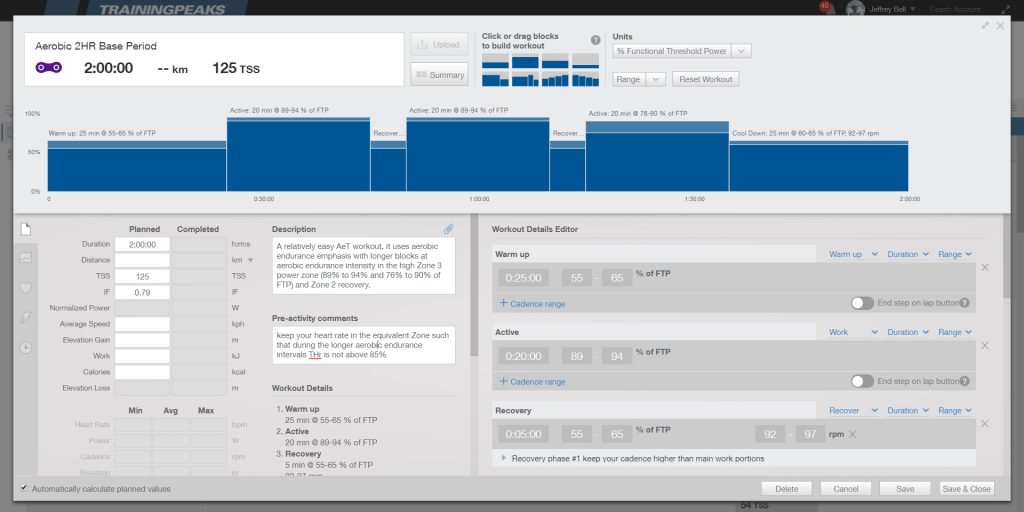
Aerobic Power Training with Limited Time
Adequate aerobic endurance training can be fulfilled by utilizing intervals that train almost the full aerobic energy spectrum. Individual response will vary, but 1 to 2 rides a week at 1.5 to 2 times your required distance with aerobic endurance power at 76% to 95% of functional threshold power (Zone 3 to 4).
By combining intervals at durations of 10 to 30 minutes during interval sessions (see Figure 7 above) that exploit power in the upper Zone 3 range they will develop adequate aerobic endurance and a supportive “base” for max aerobic and greater intensity training. Expect a 2 hour aerobic endurance workout to generate 95 to 125 TSS. This is in contrast to the longer time duration (4 plus hours) in the training of classic endurance training, i.e. Zone 2 (56% to 75% of FTP). You are always going to benefit from a longer endurance ride of 4 to 6 hours. However, if time is not available, and you are trying to improve aerobic endurance power a couple of two hour rides a week at low endurance (Zone 2) are not going to result in development of aerobic endurance, as training load is not accumulated adequately.
This is illustrated in Figure 8 and 9 below, through the Training Impact Score (TIS) provided by the WKO5 software. It uses your power data and your unique power-duration curve to estimate the anaerobic and aerobic system impact of the applied training load of a workout. In this illustration for a given workout or ride, the relative weighted strain on the aerobic and anaerobic systems and their contribution to the training impact provides deeper insight into how the workout will strain each system. Your TIS is based on the specific impact of the workout on your unique physiology. All energy systems contribute to endurance exercise efforts, but to fine tune your training to your unique physiology, it’s important to build a deeper and more specific understanding of the impact/strain on each system during exercise.

Analysing the power data from training and racing will provide a great deal of valuable information to constantly and consistently assess aerobic fitness, fatigue resistance, and the training efficacy of each workout. For example, in WKO5, utilizing workout TSS (Training Stress Score) and workout strain, reflected in TIS (Training Impact Score), and then follow up by monitoring the Stamina training metric will help answer the question of how much aerobic development is achievable, necessary and sustainable.
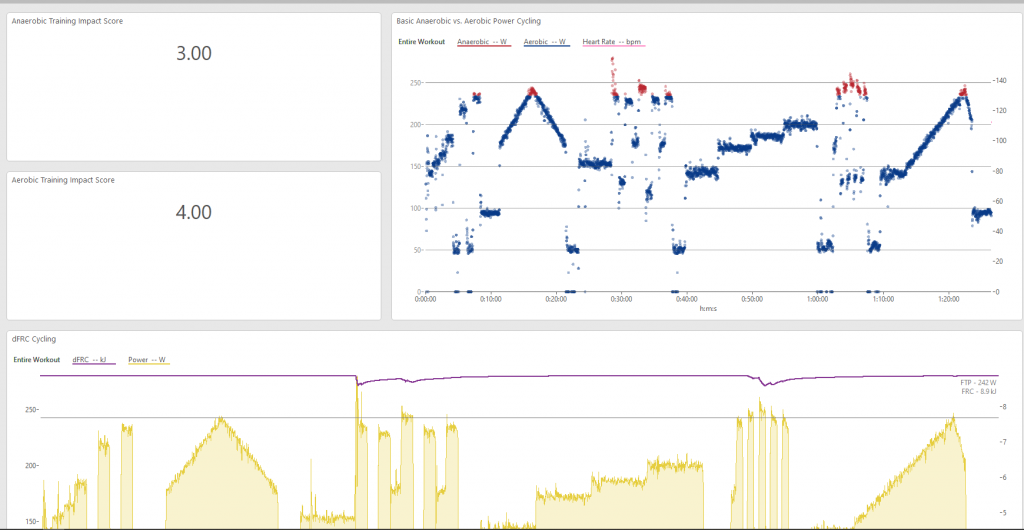
The typical athlete’s limiting factors at higher intensity aerobic effort levels is their power at lactate threshold (AnT – anaerobic threshold), encapsulated in the more accessible (measurable) functional threshold power (FTP), and their maximal aerobic power (VO2 max).
However, beyond one hour of endurance activity the role of fatigue resistance and muscular endurance begins to weigh heavily. This is represented by the Stamina metric in WKO5 and Training Peaks™. Increasing overall duration during training is the simplest way to increase your base fitness and increase stamina. This will be most effective if it occurs in the appropriate training zones, Zones 2 to 4 as mentioned above, but can typically be done in the early and later phases of a training season.
A common strategy of increasing total training duration at a steady 10 percent per week has been around for a long time for a reason: it is a smart way to build stamina. It’s important to note that just building time should not be the focus; building time at the appropriate effort is imperative to success. As duration increases the athlete should ensure the progression of time in Zone 2, Zone 3, and Sweet Spot (84% to 97% of FTP) to maximize aerobic conditioning.
The reason pros still need to spend a lot of time combining high volume with high intensity is that they need to make race winning moves after 4000 Kj of work or 180 km of racing. Aerobic endurance is a limiting factor for them because of the power demands required in the final hour of much longer elite-level events. If you’re not a pro you can be completely prepared for the demands of shorter events without a huge pro-style aerobic base. Ultimately, it is why cycling training is as much about building fatigue resistance (see more about that here), as it is about increasing power output.
Aerobic Endurance Performance Testing
The ability to measure aerobic fitness from athlete power data is valuable but there will often be a need to conduct explicit aerobic endurance and performance testing. A threshold test or FTP (Functional Threshold Power) test can be conducted to derive a periodic data point that allows for a physiologically encompassing reference to construct training levels. Often this will, by it’s nature, include other definitions and markers such as Lactate Threshold, Ventilatory Anaerobic Threshold, Onset of Blood Lactate Accumulation, Onset of Plasma Lactate Accumulation, Heart Rate Deflection Point and Maximum Lactate Steady State. All of these physiological markers will occur or be associated with aerobic endurance testing. Aerobic to anaerobic transition intensity is one of the most significant physiological variable in endurance sports.
As a coach and athlete I prefer to test this aerobic endurance capacity with something longer than a relatively short 20 minute FTP test utilizing the typical 95% rule. I also tend to avoid testing a full 60 minute effort as this can be skewed due to fatigue and effort dosing capabilities of inexperienced athletes.
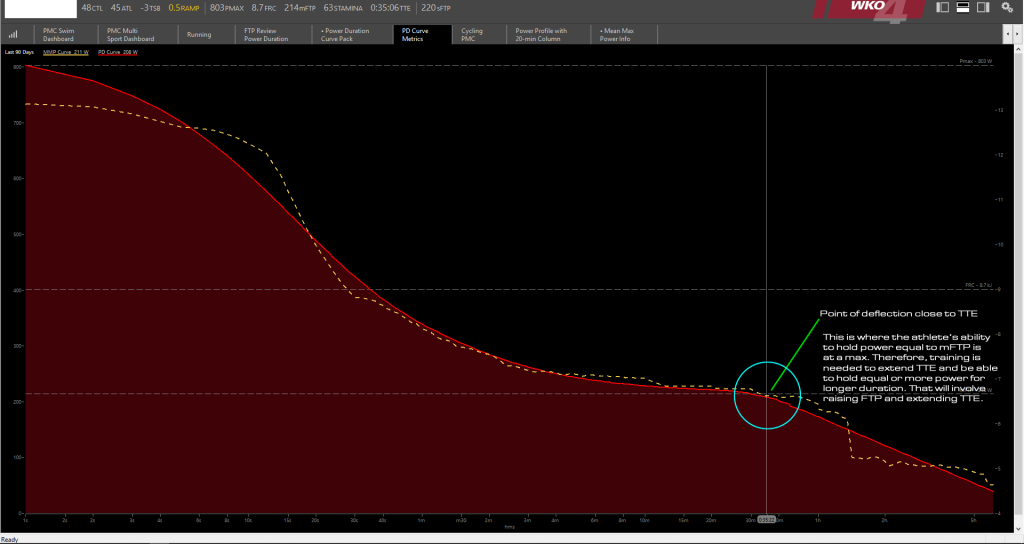
To this end, testing your aerobic endurance engine with an indicator such as FTP, is best done with a 30 minute steady state effort. At Eastern Slopes we take 94% to 96% of this 30 minute power value to derive a training zone FTP reference value. The athlete’s Mean Maximal Power MMP curve and TTE are factored in as the athlete completes ongoing workouts and longer threshold efforts to qualify the value derived from testing.
In Figure 11 below, a more robust FTP threshold test protocol is shown. This protocol is achievable with beginner athletes, not used to longer aerobic efforts at the upper end of Zone 4. It reduces the impact of anaerobic or supra maximal aerobic efforts in the test that dosing with shorter efforts can produce when the athlete goes to hard in the early part of a test.
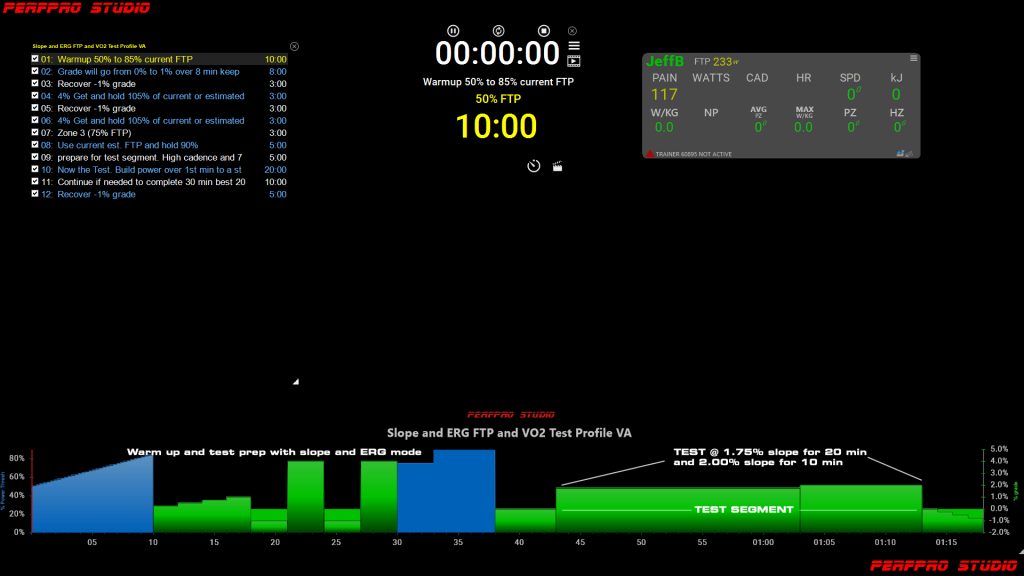
Hence pacing is critical for a valid test. This test protocol also reduces the impact and potential error that many athletes experience in their power duration relationship, especially there TTE (Time To Exhaustion), that might typically be in the range of 30 to 45 minutes rather than 55 or 60 minutes.
In Figure 12 below, you can see the actual power and effort data (grey shaded) for an athlete’s well delivered threshold (FTP) test.
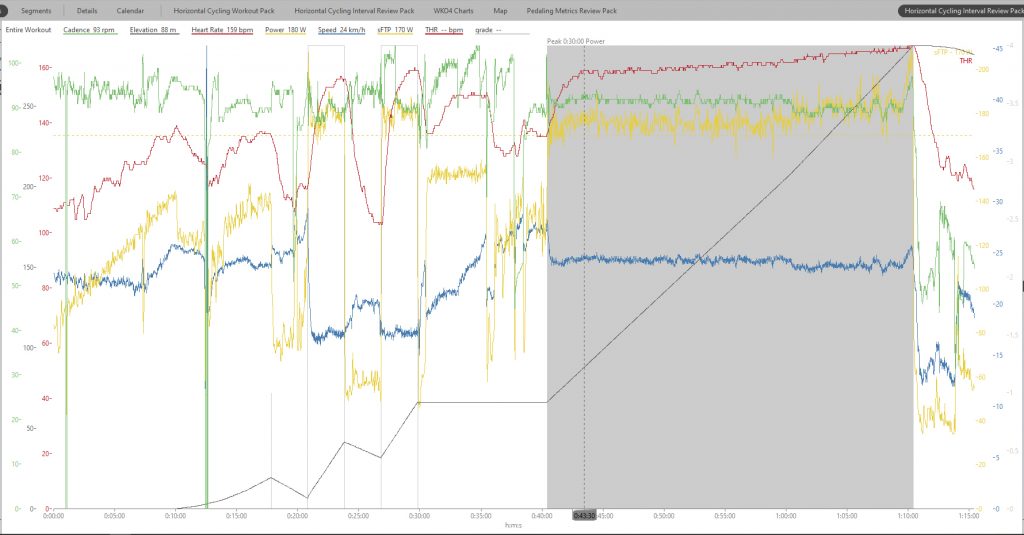
Testing one hour steady state efforts is a very demanding feat. Many athletes actually have to develop the mental and physiological skill to test a complete and well dosed 60 minute TT effort. However, a solid one hour steady state effort will probably produce a highly correlated power output to the physiological systems it is trying to represent – i.e. anaerobic threshold or lactate threshold.
Endurance coach Kolie Moore explains the thinking behind FTP testing in the link below:
https://www.trainingpeaks.com/blog/the-physiology-of-ftp-and-new-testing-protocols
Maximal Aerobic & Anaerobic Work Capacity
To train the top end of the aerobic system requires shorter higher intensity maximal aerobic intervals. Maximal aerobic capacity (VO2 Max) is stressed and trained in the time frame of 3 minutes to 5 minutes. Experienced and fit top level athletes may be able to do up to 8 min @ VO2 Max but in training the system will be stressed adequately at the lower end of this range from 3 to 5 minute duration, with optimal interval repeats and recovery.
The link below is from Training + Racing with a Power Meter: by Andrew R. Coggan, Ph.D. describes some of the methods for estimating VO2 Max from power meter data and different efforts.
http://www.trainingandracingwithapowermeter.com/2010/06/how-to-estimate-vo2max-using-power.html
In Figure 13, below, the optimized intervals calculated by the WKO5 software specifies the duration, the power high and low limits, in addition to the repeatability of intervals and recovery ratio for “max aerobic” optimization based on the athlete’s current power duration curve.
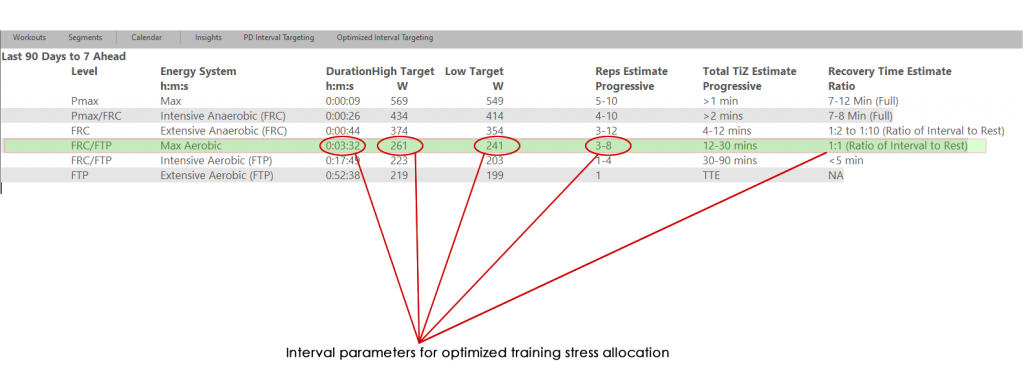
These VO2 Max (Zone 5) efforts will have a close relationship with anaerobic capacity (Zone 6) as completing maximal aerobic interval efforts the athlete will typically utilize some considerable portion of their Anaerobic Work Capacity (AWC) particularly in shorter efforts in the output range.
At anaerobic exercise intensity, incorporating maximal efforts in the time duration from 30 seconds to 2 minutes, tolerance and success is dependent upon the athlete’s ability to tolerate such training and the necessary energy capacity reflected in their AWC (Anaerobic Work Capacity).
In power based training systems AWC links in with the concepts of W Prime and Functional Reserve Capacity. Some of these metrics present some new ideas (relatively) in regards to training at higher intensities and there is plenty of discussion of the role in training and racing. The Training Peaks™ software WKO5, and coaches like Richard Wharton, have developed their use exclusively.
In WKO5 the AWC is analogous to FRC (Functional Reserve Capacity) which needs to be replenished once emptied and it can only be refilled a given number of times in any workout or race without complete extended recovery.
So-called High Intensity Energy (HIE) appears as a fitness benchmark in many new training systems, such as Xert, that works for you on a dynamic basis, and helps you determine how you can best optimise your capped energy systems like AWC and neuromuscular PMAX or peak power.
Conclusions
Energy utilization is heavily time dependent and an athlete training with power needs to become familiar with their physiological profile in order to understand this relationship. An athlete is then able to answer questions about their strengths, weaknesses, and the efficacy of their overall training prescription, and it’s effectiveness in developing fitness needs.
Training will utilize all of the bodies energy systems to some extent even if the athlete is trying to train or emphasize an individual system. For example, if you need to improve your breakaway ability in road racing or short hill efforts in mountain biking, you will have to provide your body with adequate aerobic development to permit your body the foundation to withstand and undertake the more intense anaerobic and maximal aerobic intervals and required training efforts.
This is also emphasized by scenarios that require intense efforts to be delivered after longer aerobic endurance efforts have been undertaken in the later or finishing part of a race or event. Fatigue resistance becomes a powerful determinant of performance, and your ability to produce power in less than optimal situations, i.e., not being completely fresh, becomes a critical focus.
The interdependence of energy utilization with power duration and performance outcomes is the underpinning of training planning and workout specification. It is useful for the athlete and coaches to develop an adequate understanding of these relationships. Ultimately, being able to better respond to the results and to manage the dosing of training, recovery and fueling, in both individual workouts, and in the seasonal and weekly planning of training loads and fitness development.
References:
Interaction among Skeletal Muscle Metabolic Energy Systems during Intense Exercise
Julien S. Baker, Marie Clare McCormick, and Robert A. Robergs
https://www.hindawi.com/journals/jnme/2010/905612/

